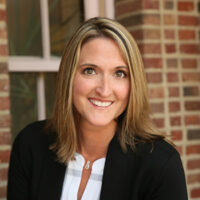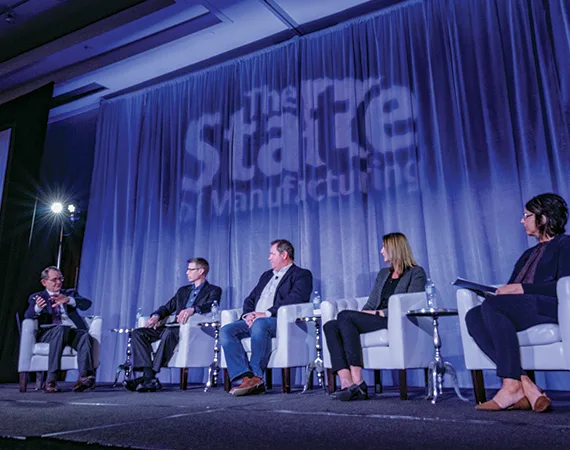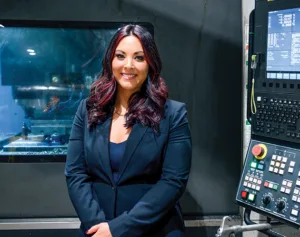View complete State of Manufacturing® results and watch the expert panelist video here.
Bob Kill: We can’t start this conversation without talking about workforce and talent. There are many aspects to this, but let’s talk about retention. Abbey, that’s your specialty. How do these poll numbers match up with your experience?

Abbey Hellickson: It is really important to pay attention to employees. I visited a company recently that had been worried about the declining morale of a key employee and that he might be looking for another job. I asked, “Have you been checking in with him?” They said, “We’ve just been so busy.” So we checked in. I think that’s important. We get busy, and we keep piling work on to our “go-to’s.” We give them the new hires, ask them to work overtime, and they do it. And that’s what this person was. When they checked in they discovered that this person had been impacted by something outside of work and needed more flexibility. They talked through things and restructured some priorities. And they’re going to retain him. I truly believe that employee retention comes from knowing where your people are at.
Jane Meyer: Attracting and retaining employees is more difficult than ever. We’ve been lucky enough to retain all but one or two of the 13 employees we’ve hired since 2021. It takes quite a while to get new employees to feel comfortable, so we put a lot of effort into a welcoming culture. New employees tell us they’ve learned more about Windings in the first couple of weeks than they knew about their previous employer over several years. They really appreciate that feeling of inclusiveness.
Kill: Roughly half of the respondents to the survey say they are involved in strategic planning and succession planning. Is that how you see it?

Steve Haarstad: Part of me thinks that the survey overstates the data when 50% of respondents say they have a strategic plan. Sometimes there might be a semblance of a strategic plan in the mind of the business leader, but it’s not necessarily vetted or communicated to the rest of the organization.
Kill: What’s our message to those companies getting into planning processes?
Haarstad: I’m a firm believer that any business has to evolve through different stages. The number of employees and technical specialties that got it to this point is a different mix of processes, systems, equipment, and people who will bring it to the next level. And if we want to grow to the next level, we have to figure out how to be a different company — to overcome challenges, even if it’s only about how you’re managing your people.
The first word that comes to mind is “deliberate.” When we think about the forward direction of our company, changes or investments can’t be made by accident. From a strategic planning standpoint, we want to have deliberate conversations as we look to set goals for three years. What does our organization look like today? What job functions do we have? How are people organized? How many more people will we need? And then forecast that forward. Where do we want to be in three years? How much more capacity will we need to achieve our revenue? And how many more customers? We may need an additional product line. We start to have a deliberate conversation about what we need to do organizationally and operationally to make all this a reality. You can literally map it out.
Kill: Matt, tell us how your company’s culture has changed since you took over for your dad and how you’ve worked with both Abbey and Steve.
Matt Hanson: Sometimes necessity is the actual reason behind whatever strategy you come up with. In 1981, our company had 450 employees in three plants. We were a leader in the Midwest, building a thousand silos a year. Then suddenly, high interest rates came, and the silo business went down. We had this huge overhead and had to come up with a new plan. We’re good at finding where we’re headed in each market, but putting it all together — succession planning down to the shop level — is where I’ve been challenged in the last couple of years.
Kill: So, with all the conversation about workforce challenges, how do you approach automation?
Hanson: We’ve added automation wherever it makes sense. I envy that some of the newer companies don’t have the baggage of still manufacturing on great grandpa’s home farm. We have a lot of old equipment. I sit on a peer council in Montevideo with guys who are adding a lot of automation, and I wonder how they can pay for it.
Kill: Jane, I’ve toured your plant. You have a different perspective on automation.
Meyer: People are surprised that our production floor is different from your typical factory. There’s not a lot of equipment, as it’s mostly a very manual process. So ergonomics is more of a challenge than automation. We want to make sure that our production people don’t do too much of the same thing. We want to get tools that fit people’s hands and make sure they do everything correctly. The fact that we’re an ESOP company keeps our employees very engaged. We all own a piece of the company, so the pressure’s on a small team to perform and make a profit.
Kill: While you have the podium, Jane, why don’t you talk about how Windings is trying to deal with the economic uncertainty around inflation. It was one of poll respondents’ top concerns.
Meyer: We want to view inflation as a strategic opportunity rather than a tactical challenge. A third of our business comes from commercial aerospace. So when the pandemic was wreaking havoc around the globe, including commercial aerospace, Windings was prepared to pivot, innovate, and look at other industries for our next big opportunity. That change in focus and priority we took in 2020 allowed us to bring to market our first-ever product offering in the history of Windings. DuraCORE is a nearly indestructible electric motor that provides down hole drilling solutions for the oil and gas industry. It was pretty exciting.
Kill: Abbey, you and Steve both facilitate peer councils. How would you describe their conversations on inflation?
Hellickson: The prospect of inflation and the possibility of a recession is a good opportunity for businesses to evaluate their strategies and think about how they manage their finances. They need to be aware of their financial position and able to read and understand all of their statements, especially their cash position going forward. They also talk about the value of knowing their customers and accounts receivable — knowing who pays and who pays on time. It’s a great opportunity to re-evaluate your business. Who are your customers? What are they thinking? Where are they? Matt, I know that you have been paying attention to this.
Hanson: We have a few different business units. We have a farm equipment distribution business, contract manufacturing, steel fabrication, and two powder coat painting lines. And then we have our precast concrete business, and inside of that, we have commercial and agricultural, and then we also do a lot of municipal stuff. We switched our entire pricing system so we could react faster. We eliminated paper price sheets. Everything is on Google Docs now. We’re trying to coach our customers to buy now because it will cost more later. Before, they would never believe you. They thought it was just a ploy to get more work. But the reality is we were more actively watching our financials.
Kill: I’m struck that when we talk about automation, we talk about machines and things. But we just heard about Google Docs. That’s automation.
Haarstad: Everybody in the room would agree that automation helps us do more with less. And yet the survey shows that automation was way down at the bottom of the list of priorities among manufacturers. I think that’s because we generalize automation as robots, cobots, and big production machines. In reality, automation can be a lot of things, such as buying a new tool that helps ergonomics for a production worker, buying a second printer so somebody doesn’t have to walk 10 steps to get their printout, or adding a Google document that we can all access dynamically. Automation can be pervasive in helping us overcome some productivity and cost challenges.
Meyer: I can add a smaller example of automation. We recently installed a visitor kiosk in our entryway to help eliminate the paper, which will also be convenient for the visitor. The kiosk will print out a special badge related to citizenship. It will alert the host when the visitor has arrived and give the visitor a short training session on Windings’ policies that might pertain to them.
Kill: Back to inflation. Steve, you work with peer councils that consist of younger executives. How do they view inflation? Some of them have never dealt with bad economies.
Haarstad: We’ve had conversations around inflation over the last three to four months, but the stories are a little different almost every month. One group might see that customers are starting to push their orders back, and others talk about rising costs. And then the next week, a different council will say that orders keep flooding in, and customers want products sooner and faster. And so it’s been really interesting. I will echo what Abbey was saying: Pay attention to the financials, especially the cash flow. In inflationary times we’re spending more and bulking up our inventory to manage our supply chain issues. Customers are taking longer to pay. Cash can evaporate over a few months and put us in trouble really fast.
Kill: Another topic in the poll related to companies wanting to be known for attracting new employees. Does it surprise you, Abbey, that “great work environment” came out on top?
Hellickson: The challenge for me is to define what a great work environment is so that you can strive for it and measure it. When I think about a great work environment, I notice organizations that work hard to create strong development programs, from onboarding all the way to thinking about how people can grow and continue to add value to their organization. Jane and her company have put a lot of time and effort into creating a great work environment.
Meyer: At Windings, we have a skill block program for production employees. A skill block program is pay based on skill and skill-progression and then competency in the form of an evaluation. We’ve had skill blocks for many years. Employees benefit from that because you can show them where they are, where they need to be, and what they need to do to get there. Much of our work with Abbey has been figuring out how to organize all that great information and use it in a different approach to training. Abbey helped us recognize the need for tribal knowledge. We have a lot of long-term employees who don’t realize what they know until you start asking questions. Our wonderful production staff worked with the training department, and operations created standard operating procedures (SOPs) for many of our processes. And those SOPs have been utilized in the training department but not nearly as much as they should have been.
Hellickson: The reason this was easy at Windings is because of the company’s values. They value the expertise of the employees who work on the floor.
Kill: So Steve, how does strategic planning fit into all that?
Haarstad: There’s both a strategic and a tactical portion of having a great work environment. It starts with having a clear definition of who we are. Our core values define how we behave, what it’s like to work, and what it feels like to be part of the organization.
Hellickson: When we think about this great work environment, Matt, you have started to think about how succession is bigger than just your senior leaders.
Hanson: That’s a great point. As Norwegians, we don’t want to talk about succession, and we don’t want to talk about profit and those kinds of things. But the reality is that those conversations are necessary. So when we finally got dad to sell the rest of the operating company, it was much easier to focus on succession. We had yet to spend time looking at those folks who are really making it happen. We needed to have conversations like, “How’s it going? When do you think you’re going to maybe fish more and work less?” Before, our strategy was, “I hope that guy doesn’t quit.” But hope is not a strategy, right? However, that’s the way we ran the company. We’re more deliberate now. We look at the role and who else can work into it. We’ve implemented skills matrices in the departments.
The last thing I’ll say is that it’s so hard to get there. I’ve been on my peer council since 2006. It’s turned over three times since then, and it’s been great every time. It’s just unbelievable what a lot of these guys have done with their business. They’ve sold businesses, started new ones, and bought other companies. I’m always asking, “How did they get there?” And it all has to do with that whole strategy, super simple concepts they wanted to stay with. And I would get frustrated that we couldn’t get there fast enough. I’ve learned not to get too frustrated because progress takes longer for an old company. Do it little by little.



